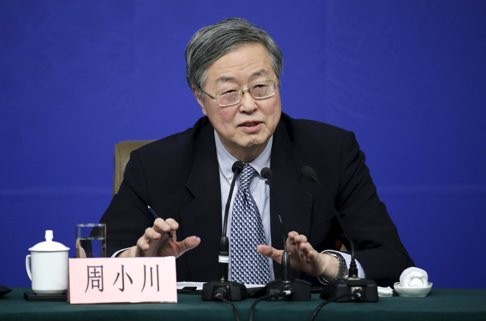
Sensitive financial data ‘missing’ from central bank report on capital flowing out of China’s slowing economy
Information on forex purchases missing from the People’s Bank of China’s list of financial figures as Beijing tries to stabilise the yuan exchange rate
Sensitive data is missing from a regular Chinese central bank report amid concerns about capital outflow as the economy slows and the yuan weakens.
Financial analysts say the sudden lack of clear information makes it hard for markets to assess the scale of capital flows out of China as well as the central bank’s foreign exchange operations in the banking system.
READ MORE: China foreign-exchange reserves drop as PBOC supports yuan
Figures on the “position for forex purchase” are regularly published in the People’s Bank of China’s monthly report on the “Sources and Uses of Credit Funds of Financial Institutions”. The December reading in foreign currencies was US$250 billion.
But the data was missing in the central bank’s latest report. It seemed the information had been merged into the “other items” category, whose January figure was US$243.9 billion – a surge from US$20.4 billion the previous month.
Another key item of potentially sensitive financial data was altered in the latest report.
The central bank also regularly publishes data on the forex purchase position in renminbi, which covers all financial institutions including the central bank. The December reading was 26.6 trillion yuan (HK$31.7 trillion).
But the January data gave information on forex purchases made only by the central bank, detailing the lower figure of 24.2 trillion yuan.
This fuels more speculation that China is under pressure from capital outflows
China’s foreign exchange reserves shrank almost US$100 billion last month as the central bank sells dollars and buys renminbi to shore up the country’s weakening currency. It followed a record US$108 billion drop in December.
Optimism for the yuan has taken a hit from continuous capital outflows amid growing concern about China’s economic outlook. The central bank has been criticised for contributing to the panic through its poor communication with the market and its foreign counterparts.
PBOC governor Zhou Xiaochuan last week told Caixin the central bank was “neither a god nor a magician”, though it was very willing to improve communication with the public.
The bank’s press office did not respond to requests for comment on the changes to its report.

“Its non-transparent method has left the market unable to form a clear picture about capital flows,” said Liu Li-Gang, ANZ’s chief China economist in Hong Kong. “This will fuel more speculation that China is under great pressure from capital outflows. It will hurt the central bank’s credibility.”
An in-house analyst at a Beijing investment bank, who asked not to be named, said the changes were technical, but reflected the PBOC’s intention to blur China’s real capital flow.
READ MORE: Why China will not sharply devalue the yuan
It is common practice to calculate China’s capital outflows by studying the gap between positions on the yuan in the financial system and at the central bank alone. But the latest changes render such calculations impossible now, analysts say.
Mizuho Securities Asia chief economist Shen Jianguang said the change could be merely a technical issue.
“But the PBOC should have given an explanation before or in tandem with the change,” he said. “It would be much better than providing an explanation only afterwards.”
All forex-related data released by the central bank is closely monitored by financial analysts. They often read item by item from the dozens of tables and statistics to try to spot new trends and changes.
China Merchants Securities chief economist Xie Yaxuan said the PBOC would not be able to conceal data as there were many ways to obtain and assess information on capital movements.
“We are waiting for more data releases such as the central bank’s balance sheet and commercial banks’ purchase and sales of foreign exchange released by the State Administration of Foreign Exchange for a better understanding of the capital movement and to interpret the motive of the central bank for such change,” Xie said.


